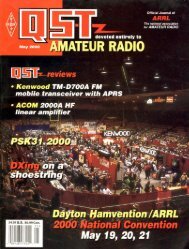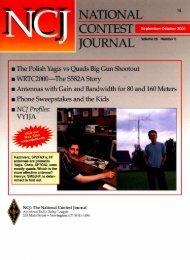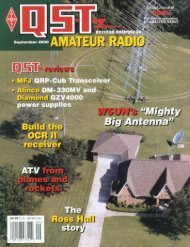DIGITAL DIMENSIONWinLink <strong>2000</strong>: A Worldwide HF BBSRemember the good old days, when youchose the best bulletin board system (BBS)in your neighborhood to serve as your“home BBS?” All your radio mail wouldbe addressed to you at your home BBS(you@yourhomebbs) and when youwanted to read your radio mail, youconnected to your home BBS.Problem was that when you were out oftown, on the road and out of range of yourhome BBS, you could not get your radiomail. Unless your home BBS provided alandline dial-in service and you weresomewhere where you could dial-in, youhad to wait until you got home before youcould receive your radio mail.The times have changed and today, thereis an HF BBS service that allows you topick up your mail anywhere in the world.The system is called WinLink <strong>2000</strong> and ithas a backbone network on the Internet,which allows all participating WinLinkmailbox operation (MBO) stations to sharetheir message databases. Therefore, a usercan connect to any participating WinLinkMBO in the world to send or retrievemail—doing away with the necessity ofhaving a home BBS.WinLink <strong>2000</strong> is a Windows applicationthat permits messages to be transferredautomatically between remote AmateurRadio stations and the Internet. “Remote” isdefined here as not having landline access.Therefore, WinLink <strong>2000</strong> provides Internete-mail access for maritime, recreationalvehicleand other remotely located AmateurRadio operators, enabling those traveling tomaintain contact with family and friends,regardless of their location.WinLink <strong>2000</strong> is the latest addition tothe WinLink suite of programs that permitPACTOR and PACTOR II Amateur Radiostations to use the Internet for the transferof messages that comply with the existingthird party traffic rules. In the August 1996installment of this column, I wrote abouthow APLink, a DOS AMTOR application,had evolved into WinLink. Three and onehalfyears later, I am writing how JimCorenmen, KE6RK; Hans Kessler, N8PGR;Rick Muething, KN6KB; Victor Poor,W5SMM and Steve Waterman, K4CJX, aretaking WinLink into the 21st century asWinLink <strong>2000</strong>.WinLink <strong>2000</strong> is a BBS that provides forHF-to-HF and HF-to-VHF text messagetransfer as well as HF/VHF-to-InternetK4CJX’s WinLink <strong>2000</strong> Web page (http://winlink.org/k4cjx/) is the source foreverything you want to know about the software and more.e-mail transfer. It uses PACTOR I andPACTOR II for semi-automatic HF operation.The WinLink <strong>2000</strong> software scans theHF amateur bands continuously. Scanningtakes approximately 1.2 seconds perfrequency, with 8 to 21 frequencies to scandepending on propagation and time of day.When the software detects a station tryingto connect with it, it parks on that frequencyto send and receive traffic with that station.From the system operator’s point ofview, WinLink <strong>2000</strong>’s modularity permitsa Sysop to run any one mailbox on differentcomputers. For example, all controlmodules may run on a computer in theSysop’s shack, while some or all TNC portcontrollers operate miles away at anyremote location with Internet access.From the user’s standpoint, accessing aWinLink <strong>2000</strong> MBO is the same asaccessing a WinLink MBO. You need notuse special software. Whatever you use forPACTOR or PACTOR II will do the job.There is software available that makes themailing process easier, however, likeAirMail. Just connect to the WinLink stationof your choice and you are off and running!Note that not all WinLink stations haveimplemented the Internet connection.Here is a very boring, but very useful listof frequencies used by the K4CJX WinLink<strong>2000</strong> MBO. Center frequencies: 3618.9,3620.9, 3621.9, 7070.4, 7072.4, 7073.9,7075.9, 7076.9, 10121.9, 10122.9, 10123.9,10125.9, 10126.9, 14064.9, 14065.9,14069.9, 14071.9, 14072.9, 14073.9 and14076.9 kHz. For LSB, call 2.1 kHz abovethe center frequency, for USB 1.9 kHz below.Support for WinLink <strong>2000</strong> is available atwinlink.org/k4cjx/, where you can find adownloadable version of AirMail that iscompatible with WinLink <strong>2000</strong>, as well as alot more information regarding the system.APRS ReduxI often mention APRS in this column andwhenever I do, readers ask me “What isAPRS?” To answer those questions, I havewritten a new book APRS: Tracks, Mapsand Mobiles, which should be availablefrom the ARRL and your favorite ham radiodealer by the time you read this. 1Also, available from your favorite hamradio dealer is a new dual-band (144 and 440MHz) mobile transceiver from Kenwood(the TM-D700A), which, like the TH-D7Ahandheld introduced a year earlier, has abuilt-in TNC and APRS software. Unlike thehandheld, the mobile APRS radio candigipeat. The radio has been the main topicof conversation on the TAPR hot technologyAPRS (HTAPRS) e-mail list for a monthnow, as owners are making new discoveriesabout the radio every day. (To subscribe toHTAPRS, go to http://www.tapr.org/.)1ARRL Order #7741, ARRL publications areavailable from your local ARRL dealer, ordirectly from the ARRL. See the ARRL Bookcaseelsewhere in this issue, or check outthe ARRL Web site at http://www.arrl.org/catalog.Stan Horzepa, WA1LOU One Glen Ave, Wolcott, CT 06716-1442 wa1lou@arrl.net, www.tapr.org/~wa1lou90 <strong>March</strong> <strong>2000</strong>
QRP POWEROf Tuna Tins, Black Cats and Zombies…It was a “dark and stormy night….” Notreally. It was a beautiful Connecticut eveningwith the ambient temperature around 50º.Pleasantly mild for a Halloween weekend inNew England. The large, golden harvesthalf-moon was sitting just above the VHF/UHF antenna stack as we walked across theARRL Headquarters parking lot, pushing anequipment cart loaded with QRP gear towardthe rear entrance of W1AW, the Hiram PercyMaxim Memorial Station.Ed Hare, W1RFI, “Head Lab Rat”, hisable-bodied assistant Mike “Igor” Tracy,KC1SX, and I were on a mission. It wasabout 2330 (local time) on October 29, 1999.We had packed up the original Tuna Tin-2transmitter built by Doug DeMaw, W1FB in1974 along with some other gear and wereabout to activate W1AW during the NorCalZombie Shuffle, which was currently inprogress. This was to be followed over theremainder of the weekend by the Black Cat/Tuna Tin-2 Operating Event, where QRPerswere encouraged to build and use updatedcopies of the famous TT-2 transmitter.The Evening HuntOur little group entered the station just asthe Friday bulletin transmissions were wrappingup. Ed went to work setting up the originalDeMaw TT-2 with the Ten-Tec Omni-VIas the receiver in Studio 1. Studio 2 becamethe 20-meter Tuna Tin-2 station and Studio 3took care of 30 meters. It was deemed early onthat 80 meters would be almost useless, so wedidn’t plan on any 80-meter operation.Prior to moving over to W1AW we hadtried some 40 meter QSOs during the ZombieShuffle (CQ BOO!) from W1INF, theARRL club station in the Headquarters buildingitself, using the W1AW callsign. Ed managedto work about 10 Qs and I followed witheight. Once we got set up at W1AW, the firstthing we noticed was the tremendous noiselevel on 40 meters. Ah, yes…<strong>2000</strong> of our closestEuropean friends working the CQ WW DXtest. Such is life. Despite the cacophony ofnoise on 40, I did manage several Qs withsome stalwart Zombies, including GrandZombie # 004, Paul Harden, NA5N himself!SaturdayBy 11 AM Saturday morning I was consciousand ready to get back to W1AW. JoeBottiglieri, AA1GW, picked me up at a localrestaurant and we drove back to HQ. Shortlyafter arriving I was back on the original TunaThe author ensconced in W1AW Studio1 with the Tuna Tin II.Ed “Head Lab Rat” Hare, W1RFI.Tin-2 making QRP contacts on 40 meters.Band conditions were excellent and the littlemilliwatt transmitter worked flawlessly,allowing many QRPers to have the experienceof working a rig steeped in history.Around noon, Joel Malman, K1QM,arrived to lend a hand. He brought his keyboardand interface unit. This was the firsttime I’d had a chance to use one of these devicesand found that I liked keyboarding CW.Since I am a touch typist I can rapidly loadup a buffer and, while the rig is being keyedby the keyboard interface, I can complete thelog entries. This greatly speeds up the QSO/logging duties.Joel settled in on 20 meters and after aboutan hour came out of Studio 2 happily complainingabout the pile up he was creating on14060 kHz! Remember, we were operatingfrom “Ham Radio Mecca” so it must have beenRICK LINDQUIST, N1RLRICK LINDQUIST, N1RLa combination of the location and theHalloween season that was responsible for allthe insane action on the QRP frequencies.Shortly after noon, Dave Benson, NN1G,came over to the station. It’s always goodto visit with Dave. The outcome of his visitwas a Small Wonders Lab DSW-40 transceiverkit that I had wanted to purchase.Having seen the prototype in February, I hadbeen lusting after one of these kits for severalmonths. Luckily Dave had a spare kitavailable and I bought it on the spot.Unfortunately competition with Europeanphone stations on 40 meters caused Edto shut down that station about 8 PM. Joeland I were taking turns on 20 meters. WhenJoel was on 20 I worked 30 meters and manageda few QSOs despite the S-9 noise level.The highlight of Saturday evening occurredwhen I heard Jim Larsen, AL7FS, inAlaska calling me on 20 meters. It had beena couple of hours since we had changed batterieson the 20-meter Tuna Tin-2, so ouroutput was down a bit. I completed the QSOwith Jim, netting Alaska, and then noticedthat our 3-element 20-meter monoband beamwas pointed 90 degrees away from Alaska! Ihad worked Jim with the beam broadside tohim. Ed measured the power output of the TT-2 and confirmed it was about 300 mW! Is QRPup to the task? You tell me!A special “thank you” to LarryWolfgang, WR1B, and his wife Jean,WB3IOS, and Rick Lindquist, N1RL, formaking this trip to Newington a great experiencefor me and my family.QRP WebSurfOur Web destination this month is the NewJersey QRP Club’s terrific site. The main reasonI am directing you to this site is to plugthe second annual Atlanticon QRP gatheringat the Ramada Inn in Glenn Mills, Pennsylvania(near Philadelphia) on <strong>March</strong> 24 and25. Atlanticon is the QRP event on the EastCoast. Guest speakers include Chuck Adams,K7QO, Dave Benson, NN1G, Joe Everhart,N2CX and Gary Diana, N2JGU. There is a$10 registration fee. All the details are availableon the NJ QRP Club’s Web site at: http://www.njqrp.org. For those of you who are“Web challenged”, contact George Heron,N2APB, at 2419 Feather Mae Court, ForestHill, MD 21050 for details. Rooms at theRamada Inn are $79 + tax per evening. Contactthe Ramada at 610-358-1700 to makereservations.Rich Arland, K7SZ 25 Amherst Ave, Wilkes Barre, PA 18702 k7sz@arrl.org<strong>March</strong> <strong>2000</strong> 91
- Page 6 and 7:
March 2000 Volume 84 Number 3David
- Page 11 and 12:
THE AMERICAN RADIORELAY LEAGUE INC
- Page 14:
Get to Know Your Section ManagerThe
- Page 18:
Senate CommerceChairman andPresiden
- Page 22 and 23:
GEORGE DOMINICK, W4UWCLooking for a
- Page 26 and 27:
CORRESPONDENCEYour opinions count!
- Page 30 and 31:
By Stephen Stuntz, N0BFImagine ridi
- Page 32 and 33:
By David A. Rosenthal, N6TSTDXing W
- Page 34 and 35:
It was a ham’s dream, sitting onM
- Page 36 and 37:
always start at the beginning of me
- Page 38 and 39:
An insideview of theQRSerprototype.
- Page 40 and 41:
Kits and BoardsWhile the original T
- Page 42 and 43: TT2 PerformanceKeying quality with
- Page 44 and 45: Figure 1—Schematic of the meter-m
- Page 46 and 47: Figure 1—Schematic of the Simple
- Page 48 and 49: tacts I had while using this transm
- Page 50 and 51: chandisers are free to develop “s
- Page 52 and 53: WORKBENCHPROJECTS AND INFORMATION F
- Page 54 and 55: THE HELP DESKSchematic Symbols52 Ma
- Page 56 and 57: paddle. This can be done with eithe
- Page 58 and 59: creator) was providing free PSK31 s
- Page 60 and 61: By H. Ward Silver, N0AXTest Your Kn
- Page 62 and 63: HINTS & KINKSA SIMPLE ANTENNA FLIPP
- Page 64 and 65: By Dave Patton, NT1N2000 Annual Mee
- Page 66 and 67: The Board welcomed three new Vice D
- Page 68 and 69: Craigie nominated Mr. Butler. Mr. B
- Page 70 and 71: D.C., with the specific responsibil
- Page 72 and 73: Table 1Elecraft K2, serial number 0
- Page 74 and 75: two inductors. Don’t let this hap
- Page 76 and 77: Like most transceivers these days,
- Page 78 and 79: Table 2Alinco DJ-V5TH, serial numbe
- Page 80 and 81: FCC NewsENHANCED AMATEUR ENFORCEMEN
- Page 82 and 83: tem is not legal to use as it’s c
- Page 84 and 85: chance to do it. It may be several
- Page 86 and 87: officials and the hundreds of train
- Page 88 and 89: THE WORLD ABOVE 50 MHZDr. Ernest K.
- Page 90 and 91: EME AnnalsEME (moonbounce) standing
- Page 94 and 95: From the Mailbag…Throughout the y
- Page 96 and 97: AT THE FOUNDATIONSpringing with New
- Page 98 and 99: (156.7 Hz), 146.52. Adm: $2. Tables
- Page 100 and 101: It is with deep regret that we reco
- Page 102 and 103: CONTEST CORRALFeedbackIn the 1999 A
- Page 104 and 105: By Dan Henderson, N1NDContest Branc
- Page 106 and 107: Affiliated Club Competition Results
- Page 108 and 109: 1999 IARU HF WorldChampionship Resu
- Page 110 and 111: N5XU (+KA5WSS,KM5FA,N3TNN)390,104 8
- Page 112 and 113: RW4AA 1,299,804 2121 172 ARW3GU 879
- Page 114 and 115: Revised 1999 June VHF QSO Party Rov
- Page 122: has been around for some time, is a
- Page 126: 154, WB5ZED 232. Tfc: K5WOD 4, NOKW
- Page 130: Bethpage, NY. Bob Wexelbaum, W2ILP,
- Page 134: NEW HAMPSHIRE: SM, Mike Graham, K7C
- Page 138: 136longtime member N6DOC. Installat
- Page 142:
tion of the digital network within
- Page 146:
DEC, EC, ASM, and cabinet member at
- Page 150:
148agencies have had a working rela
- Page 156:
CALL SIGN NAME BADGES. Club logos o
- Page 160:
COMPUTERS - WANTED early Pre-1980 m
- Page 176:
Index of AdvertisersADVERTISING DEP
















